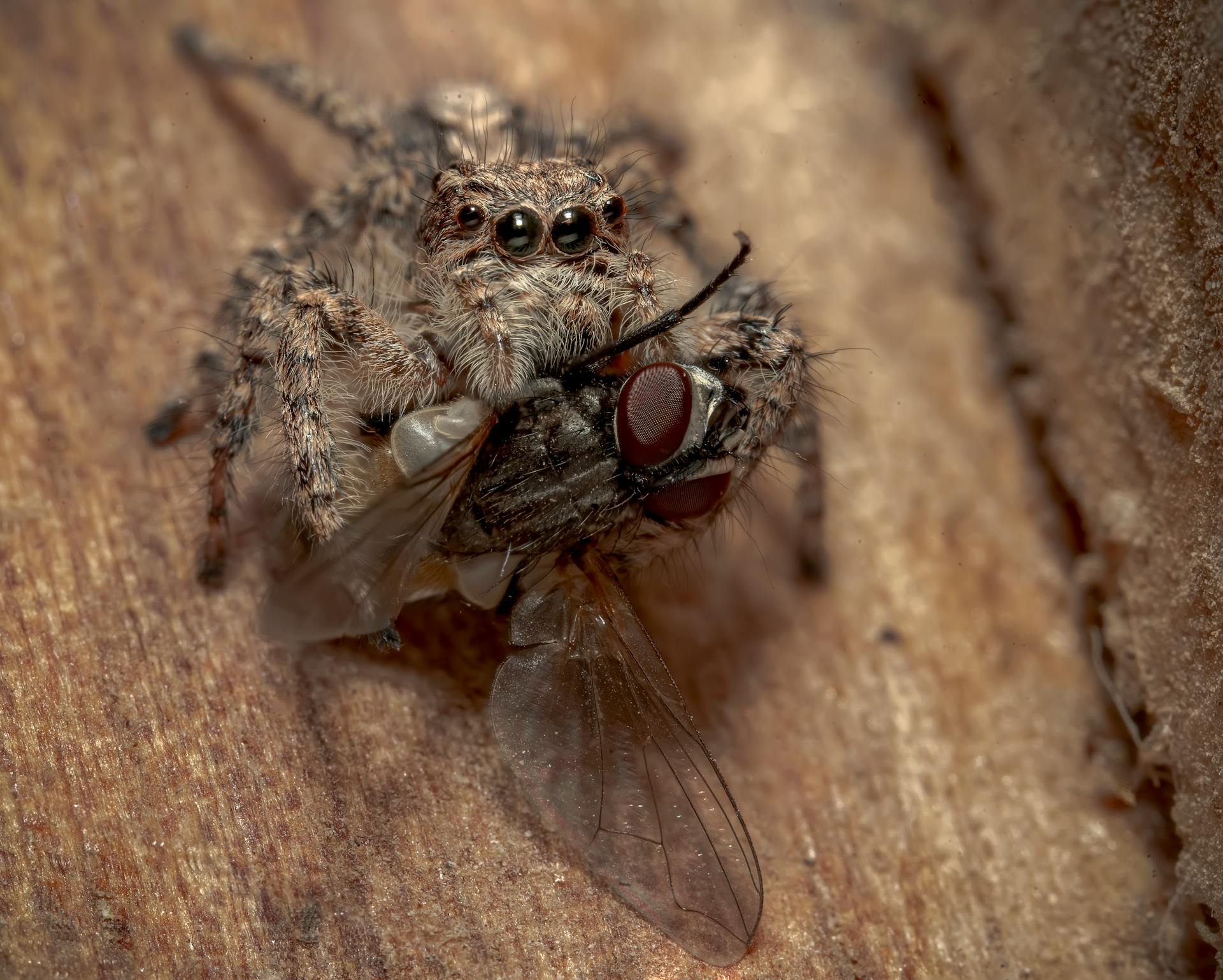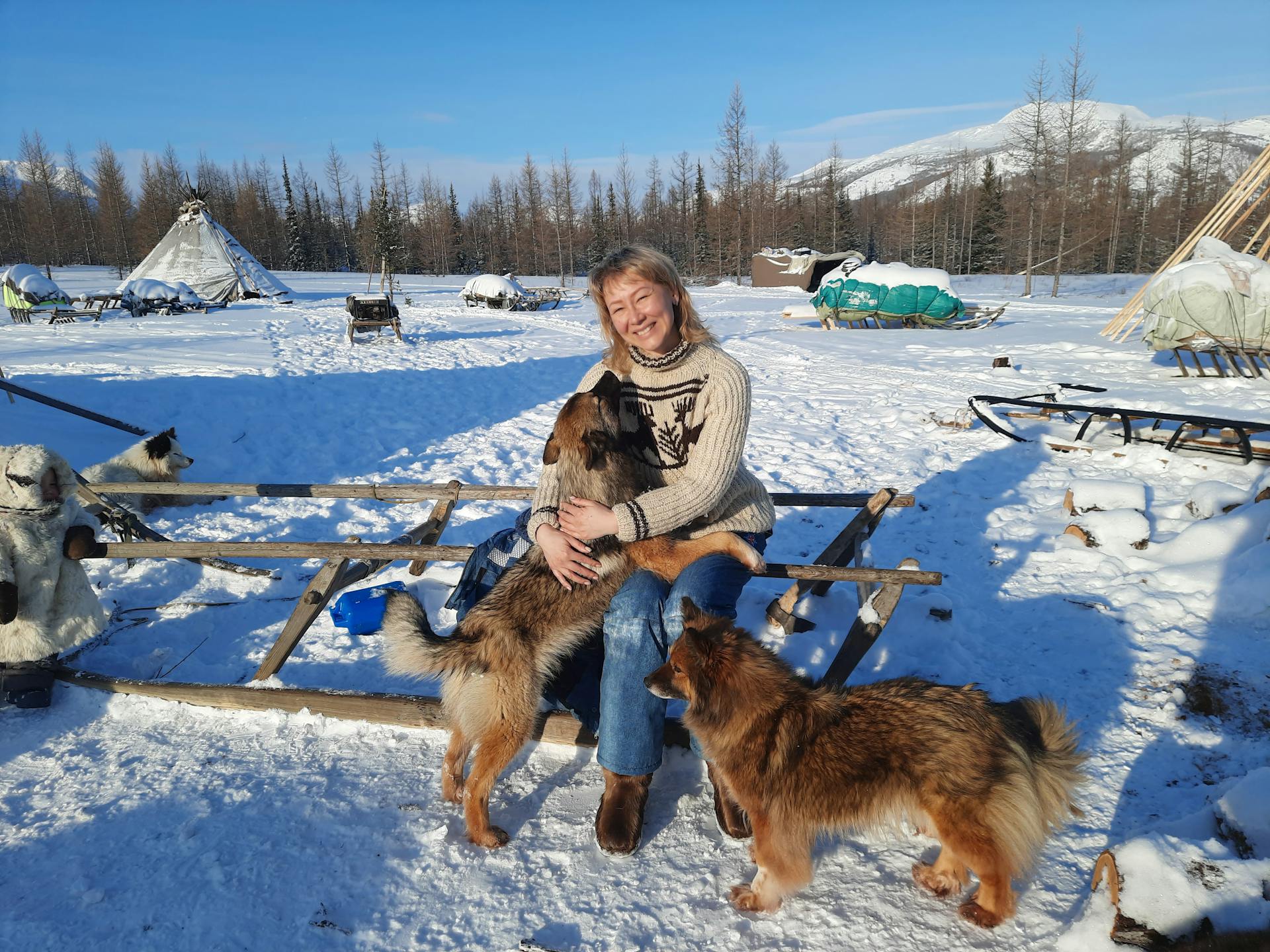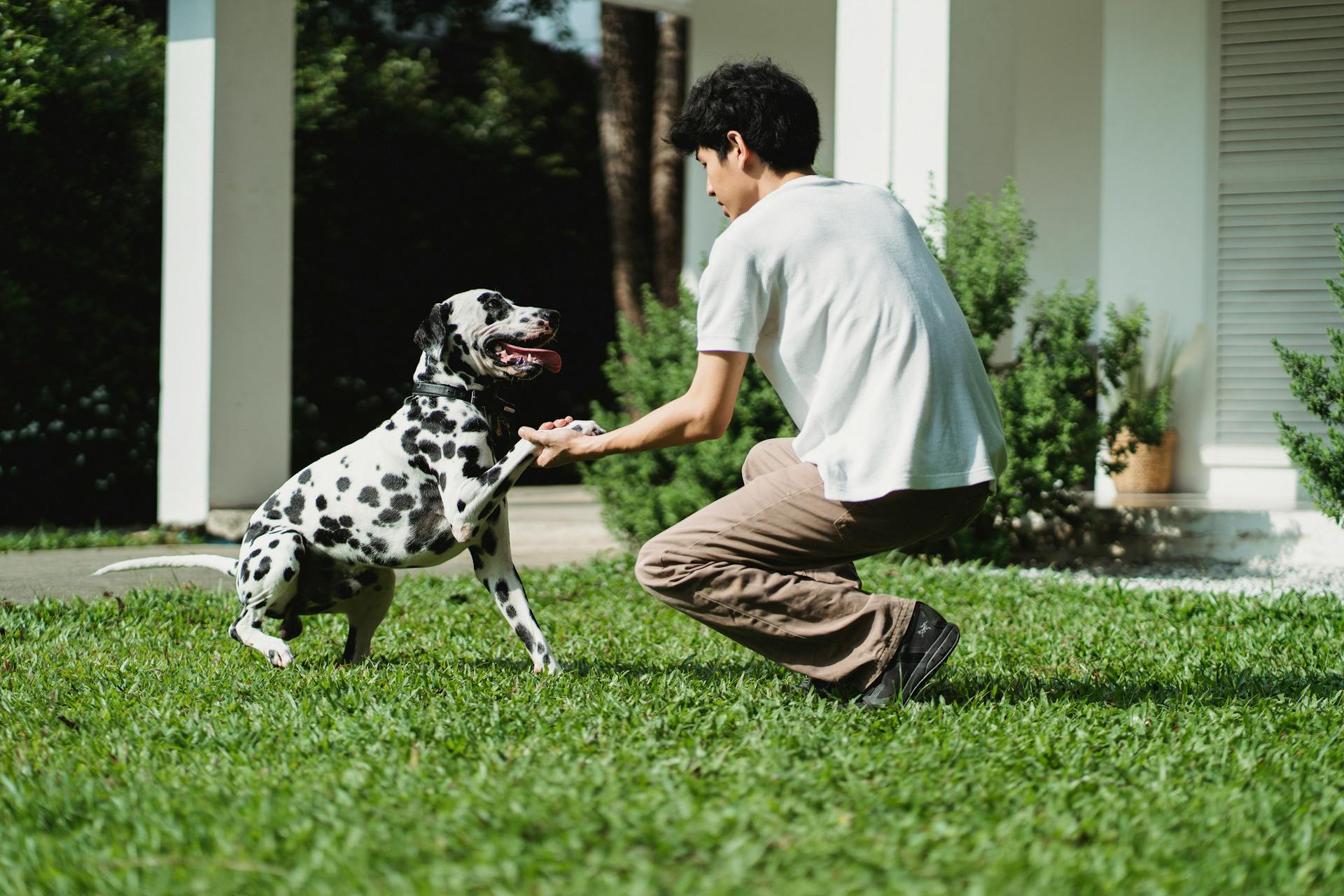
Reducing prey drive in dogs requires a multi-faceted approach that starts with understanding the underlying causes. Dogs with high prey drive often have a strong instinct to chase and catch small animals.
Exercise is a crucial factor in reducing prey drive, as a tired dog is a calmer dog. Regular physical activity can help burn off excess energy and reduce the likelihood of your dog engaging in high-prey drive behaviors.
A well-designed training plan can also help reduce prey drive by teaching your dog to focus on you and ignore distractions. By incorporating obedience training into your daily routine, you can help your dog develop self-control and impulse management skills.
Consistency and patience are key when working with a dog that has high prey drive. With time and effort, you can help your dog learn to manage their instincts and become a more well-behaved companion.
On a similar theme: Does Spaying a Dog Help with Aggression
Understanding Prey Drive
Prey drive is an instinctual behavior that drives dogs to notice, chase, or capture prey. It's what makes some breeds, like Border Collies and German Shorthair Pointers, naturally inclined to pursue smaller animals.
Prey drive can manifest in various ways, such as herding small children around the house or chasing the family cat, and its intensity can vary from dog to dog, even within high prey drive breeds.
Sudden, spastic movements can trigger an instinctual reaction in dogs, making it essential to be aware of your surroundings and potential triggers when managing prey drive.
What Is?
Prey drive is an instinct for a dog to chase, stalk, or catch smaller animals. It can be triggered by sudden, spastic movements.
Dogs might target animals as small as birds or as large as deer on the tree line of your backyard. This instinctual reaction can be a challenge to manage.
Smaller pets and livestock can be at risk if you have a dog with strong prey drive.
Why Breed Matters
For generations, many breeds were developed to hunt, and this instinct is still embedded in their DNA, making it tough to teach them otherwise.
The natural lineage of a breed can make a big difference in their behavior. Certain behaviors pass through bloodlines, making many breeds more susceptible to exhibit these behaviors than others.
Some breeds have a higher prey drive than others, which can be a concern for pet owners. The breed groups with the highest prey drive include hounds, retrievers, herding dogs, working breeds, and terriers.
It's essential to consider the breed's natural instincts before bringing a dog home. If you have a dog that won't break its hunting habit, you'll have to take other precautions to protect other animals.
Dogs with low prey drive instincts are less likely to chase or pursue other animals, making them excellent pets for multi-dog households or homes with small children.
Check this out: Chow Dog Breed Aggression
Recognizing Signs
Dogs with high prey drive often display specific behaviors that can be tricky to ignore.
Body language is a key indicator of prey drive in dogs, with stiffening of the body, unbreakable eye contact, and shaking with anticipation being common signs.
Additional reading: Anxiety in Dogs Body Language
Vocal reactions can also be a giveaway, with low growls or roars often accompanied by body language signs, and sometimes accompanied by barking.
If your dog is exhibiting poor behavior on the leash, such as extreme tugging to get to the prey, it's likely a sign of high prey drive.
Stalking is another common behavior, where dogs lower their bodies and heads while keeping intense visual focus on their target.
Chasing is an obvious indicator of prey drive, whether it's a bird on the ground or a squirrel up a tree.
Here are some specific signs of high prey drive to look out for:
- Fixation and staring at prey while at a distance
- Stalking or tracking while approaching or following other animals
- Lunging, chasing, grabbing, hovering above or over the shoulder of a small animal
- Signs of high excitement including upright and tense posture, teeth chattering and drooling, quickening of movement, and an upright stiff tail that is wagging quickly
Managing Triggers
Managing triggers is key to reducing prey drive in dogs. By understanding what sparks your dog's chase instinct, you can take steps to avoid it.
If your dog has a high prey drive, you've likely noticed what triggers it. Watch your dog's behavior to pinpoint these triggers, whether it's the neighborhood cat or your kids running around the yard.
Check this out: Breeds of Dogs in a Dog's Purpose
Keeping your dog on a leash when outdoors or fully enclosing your yard with secure fencing can help reduce the behavior and avoid accidentally reinforcing it.
Knowing your dog's triggers and timelines can also help you manage the situation. Pay attention to how close they become to what they consider prey before they respond, and use that knowledge to redirect their attention elsewhere.
Take a look at this: Will Getting a Male Dog Fixed Help with Aggression
Managing Triggers
Managing triggers is a crucial step in managing your dog's prey drive. By understanding what triggers your dog's high prey drive, you can take steps to avoid those situations.
To identify triggers, watch your dog's behavior and observe what sets them off. Perhaps it's the neighborhood cat or your kids running around the yard. Knowing what triggers your dog's prey drive will help you take proactive steps to prevent unwanted behavior.
Keeping your dog on a leash when outdoors can help reduce the likelihood of a trigger setting off their prey drive. Secure fencing around your yard can also help prevent unwanted interactions with other animals.
A different take: Crate Training Steps

If your dog becomes fixated on an object, try moving them to another room to break the cycle. This can help reduce the behavior and avoid accidentally reinforcing it.
By being aware of your dog's triggers and taking steps to avoid them, you can help manage their prey drive and create a safer environment for everyone.
Predation Substitution Tools
Predation Substitution Tools can be a game-changer for managing triggers related to prey drive in dogs. These tools allow your dog to perform the "safe parts" of the predatory sequence.
For example, instead of letting your dog chase deer, you can teach them to stand and stalk the deer. This way, your dog can still experience the thrill of the hunt without actually catching anything.
The idea is to give your dog an outlet for their natural instincts, rather than trying to suppress them entirely. By doing so, you can help reduce your dog's prey drive and make them more manageable in situations where they might otherwise get triggered.
As Mueller explains, your dog doesn't have to "abort all predatory behavior" - they can still stay within the predatory sequence and enjoy the happiness hormones that come with it.
Train Your
Training is a crucial step in reducing prey drive in dogs. You can't always avoid every single trigger, especially in highly motivated dogs. Training, in addition to taking steps to avoid the trigger, can help reduce issues. A good first step is to work on basic obedience training, either in a group class or one-on-one with a trainer.
This will help improve communication between you and your dog, teach you to read your dog's body language more easily, and help give you techniques to distract or deter your dog from getting overstimulated. Desensitization can also help reduce behaviors, such as with BAT techniques and other distraction and deterrence training.
Training can't completely remove an instinctual behavior, but it can help reduce escalation or overstimulation, making it easier to deter your dog away from the trigger. Puppies are trainable by seven weeks of age, and most formal training is typically most effective around the six-month marker. The earlier you start, the better.
If your dog's prey drive is too much to handle alone, consider seeking out a behaviorist. They can create a tailored plan to suit your dog's needs. Teaching your dog to respond to commands, such as "leave it", can also help you gain more control over the situation.
Recommended read: Reduce Porphyrin
Prevention and Control
Preventing your dog from chasing other animals is crucial, and it starts with understanding that you can't eliminate prey drive entirely, but you can manage it. Regardless of any training, your dog will always seek out opportunities to chase.
Securing your garden is a must, as it's a common source of temptation for dogs with high prey drive. Make sure it's fenced in to prevent your dog from running off.
Investing in a well-fitting dog harness and a long line can also help keep your dog safe while still allowing them to explore their surroundings. This can be especially useful in areas with lots of wildlife.
It's essential to have realistic expectations and understand that managing prey drive is a work in progress. You can't rely on a single solution, but rather a combination of training, management, and safety precautions.
By identifying and avoiding triggers, you can reduce the likelihood of your dog engaging in prey drive. This might mean keeping your dog on a leash when outdoors or fully enclosing your yard with secure fencing.
Distraction techniques can also be effective in managing high prey drive. Redirecting your dog to a puzzle toy or a game of fetch can help redirect their attention away from chasing other animals.
Related reading: Shock Collar for Dogs Chasing Cars
Tips and Best Practices
Managing a dog with high prey drive requires both enrichment and control. Your dog's instincts to chase and hunt can be fulfilling and rewarding for both of you.
Here are a few pieces of advice for keeping a dog with high prey drive safe while also giving them a positive outlet for their instincts: High prey drive isn't a bad thing, but it does need to be managed.
Teach your dog how to manage their urges by providing them with a positive outlet, such as a securely fenced area where they can run and play off-leash. This will help to channel their energy and satisfy their instinct to chase.
Enriching your dog's life with puzzle toys and scent work can also help to reduce their prey drive. This will keep their mind active and engaged, reducing the likelihood of them becoming fixated on small animals.
High prey drive isn't a bad thing, but it is something you need to take the time to teach your dog how to manage their urges.
For your interest: How to Teach Your Dog to Drive?
Aggression and Safety
High prey drive can be a danger to both your dog and other animals. It's not just about your dog's behavior, but also about the potential consequences of that behavior.
Dogs with high prey drive might engage in behaviors like chasing small animals, chasing small dogs, biting/nipping at small animals and children, or even chasing cars. These behaviors can put your dog at risk of getting loose, running away, or sustaining serious injuries.
Here are some potential risks associated with high prey drive:
- Chasing small animals
- Chasing small dogs
- Biting/nipping at small animals and children
- Chasing cars
If your dog gets away from you, it could lead to an entirely new realm of dangerous possibilities, including running away, getting hit by a car, or sustaining other injuries.
Can Harm Your
Dogs with high prey drive can pose a significant threat to their own well-being. If your dog gets away from you, it could lead to an entirely new realm of dangerous possibilities.
Your dog could run away, get hit by a car, and several other unfortunate things. Prey drive can cause dogs to dig or jump over fences if they are adequately secured.

Dogs with high prey drive might engage in behaviors like chasing small animals, chasing small dogs, biting/nipping at small animals and children, or chasing cars. These behaviors are especially dangerous outdoors where dogs may get loose, run away, or sustain serious injuries.
Dogs have incredibly powerful bite force, capable of ending the life of a small animal with just one bite and shake. This is a sobering reminder of the importance of managing your dog's prey drive.
Consider reading: Tail Chasing
Aggression vs
Aggression can stem from different underlying causes, and it's essential to understand the distinction between aggression and prey drive. Prey drive is an instinctual response to outside stimuli.
Fear aggression, on the other hand, is a response to perceived threats, making your dog feel like they need to defend themselves.
Understanding the root cause of aggression in your dog is crucial for addressing the issue.
You might like: Conditioned Emotional Response Dog Training
Frequently Asked Questions
How do you leash train a dog with high prey drive?
To leash train a dog with high prey drive, mimic the hunting experience before walks and reward good behavior on walks, while also working on a reliable recall. This approach can help your dog learn to walk calmly on a leash and respond to your commands.
Sources
- https://dogtime.com/how-to/110469-how-to-manage-prey-drive-in-dogs
- https://www.hepper.com/how-to-tame-prey-drive-in-a-dog/
- https://rockykanaka.com/high-prey-drive-in-dogs/
- https://www.leaveit.com.au/dog-lifestyle/what-is-dog-prey-drive-4-signs-of-prey-drive-how-to-control-it/
- https://www.akc.org/expert-advice/training/channel-control-dog-prey-drive/
Featured Images: pexels.com


